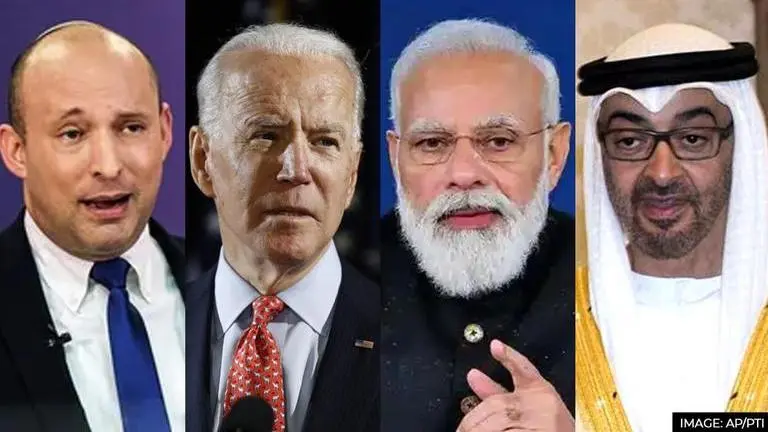Updated 25 October 2021 at 15:02 IST
India forms new 'quad' with UAE, US & Israel: What is it? How will it counter China?
In a bid to counter China's 'expansionist' ambitions, India has teamed with United States (US), United Arab Emirates (UAE) and Israel to form a new 'quad'
- India News
- 4 min read

In a bid to counter China's 'expansionist' ambitions, India has teamed with United States (US), United Arab Emirates (UAE) and Israel to form a new 'quad' in the Middle East (West Asia). With climate change, energy and regional security in focus, India's new quad deal comes in the background of the Israel-US-UAE 'Abraham accords' which normalised Israel-UAE ties. Moreover, India's talks with China over de-escalation at the Line of Actual Control (LAC) have reached an impasse as the 13th round of talks were not fruitful after Chinese side did not agree to any of India's forward-looking proposals.
What is new Quad?
On October 18, Israel, the United Arab Emirates, and the United States began a new quadrilateral economic forum which will deal with climate change, energy, and maritime security. Similar to the original Quadrilateral Security Dialogue of India-US-Australia-Japan, this new quad engages India and US' cooperation against instability. While the original quad reortedly counters China, this quad targets the instability in the Middle East (West Asia). As per reports, the new quad meeting was joined by India's External Affairs minister S Jaishankar, US State secretary Anthony Blinken, Israeli foreign minister Yair Lapid and UAE foreign minister Sheikh Abdullah bin Zayed Al Nahyan.
On the other hand, the first in-person meeting between the original 'Quad' partners wash held during PM Modi's 3-day tour in US. The QUAD partners - US (Joe Biden), Japan (Yoshihide Suga), India (PM Modi), Australia (Scott Morrison) held a joint meeting and vowed to bolster infrastructure, 5G, ASEAN cooperation, COVID vaccine partnership and announced a new ‘Quad fellowship’ for STEM. The quad's main aim has been to counter China's maritime ambitions in the South China sea, with US-Australia announcing a new AUKUS submarine deal, miffing ally France.
Does the new Quad counter China?
As China takes on the European nations - UK, France, European Union, Germany and other global powers like Australia, Canada and the US to shift the world superpower, several multilateral coalitions have spurted - Five eyes (US, UK, Australia, Canada and New Zealand), AUKUS (Australia-US), Quad (US, India, Japan, Australia) etc. Similarly, the new 'quad' aims to counter China's monopoly in the 5G race, semiconductors, technology, space and also limit its expansionist ideas - opening up new ports, naval base, surveillance and military incursions in South China sea and on land. Combined with UAE's capital and oil resources, Israel's advanced technology, India's manufacturing abilities and US' global demand, the new quad is a major power with geopolitical, security, climate and strategic intent.
Advertisement
Abraham Accords & Quad summit
Amid COVID, another Middle East coalition had sprung in August 2020, when the United Arab Emirates, forged ties with Israel and US, recognising the Jewish state for the first time. UAE-Israel ties' normalisation was facilitated by the then-US President Donald Trump after Israeli PM Benjamin Netanyahu held six weeks of indirect talks through Jared Kushner, Trump's son-in-law and senior adviser with Abu Dhabi Crown Prince Sheikh Mohammed Bin Zayed. Following UAE, Sudan, Morocco, and Bahrain too recognised Israel. While most nations have welcomed the deal which ended may end 72 years of hostilities in the region, Iran, Hamas have condemned the move raising concerns about the fate of Palestinians in the region. Apart from UAE, Egypt and Jordan are the other Arab nations that have forged peace with Israel.
Indo-China ties
The 13th round of Corps Commander-level talks between India and China failed to yield any outcome owing to the stubborn attitude of the latter. Calling out the "unilateral attempts" by the People's Liberation Army to alter the status quo, the Indian Army recalled that External Affairs Minister S Jaishankar and Chinese Foreign Minister Wang Yi had agreed in their recent meeting in Dushanbe to resolve the remaining issues at the earliest. At the same time, it added that the two sides have agreed to maintain communications and stability on the ground.
Advertisement
Over the past military talks, the Chinese People's Liberation Army has retreated from the Finger 4 area and Patrol point 14 along the LAC, while India pre-empted PLA activity on the Southern Bank of Pangong Tso Lake capturing positions of 'strategic importance' in the Fingers area. While disengagement has completed north and south of Pangong Tso, it is yet to be completed in friction points such as Hot Springs, Gogra and Depsang. 20 jawans were martyred on June 5-6, 2020 amid a violent face-off between Indo-China troops at LAC's Galwan Valley.
Published By : Suchitra Karthikeyan
Published On: 25 October 2021 at 14:58 IST
